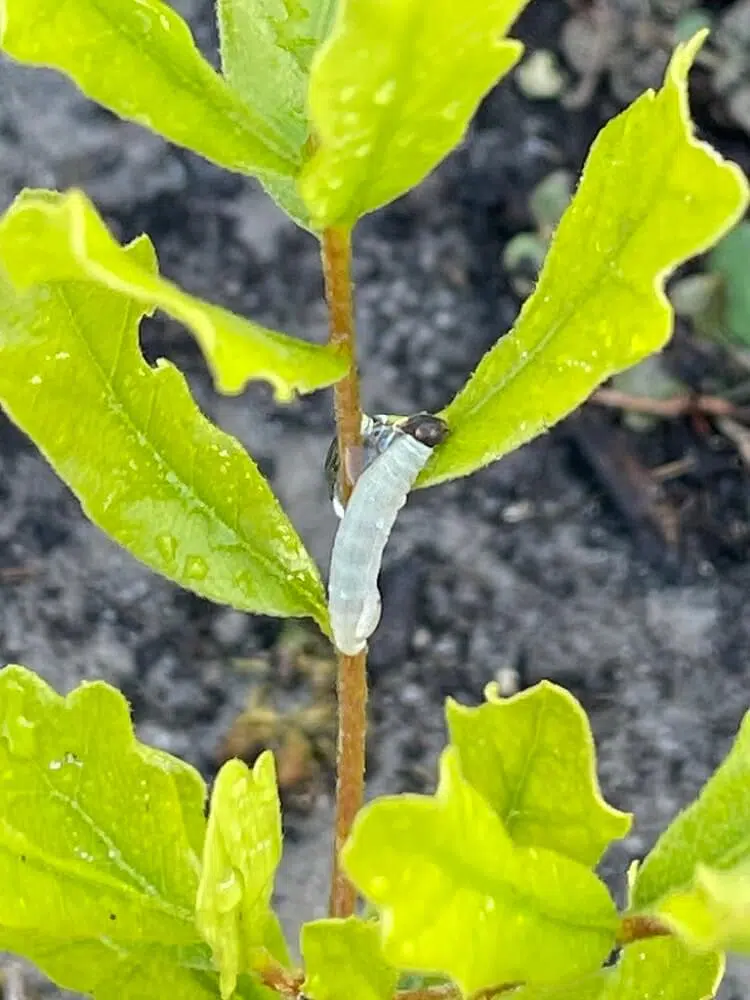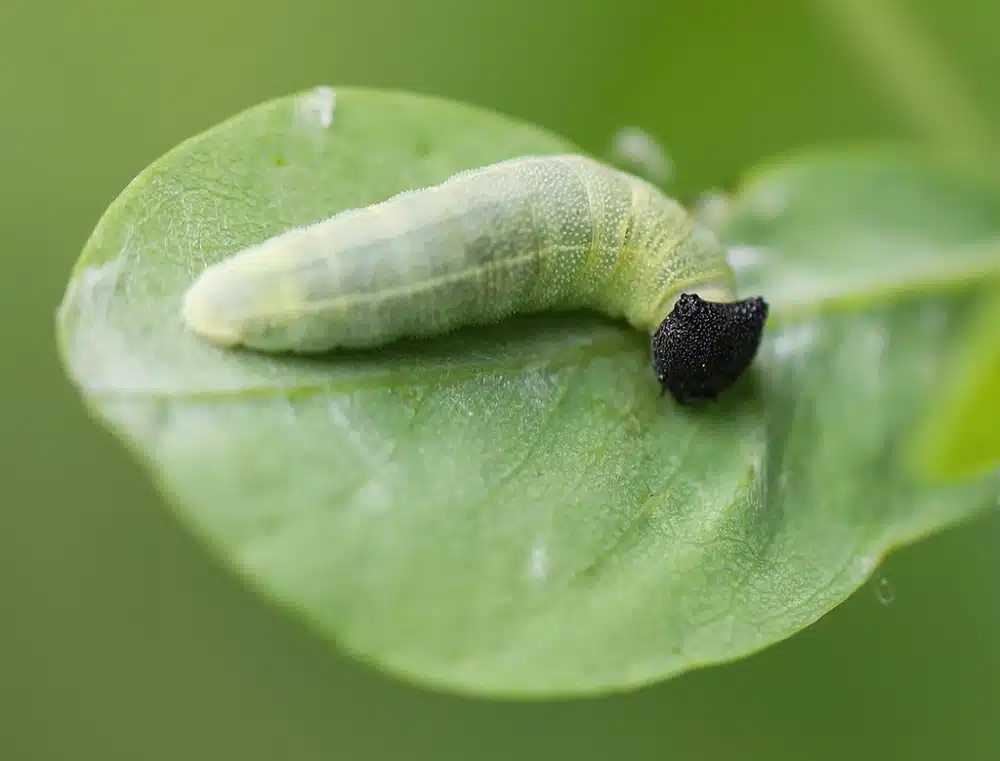Caterpillars come in a variety of colors and patterns. Some have hair, others are hairless. They all transform into butterflies or moths. If you have been gardening lately or you encountered a caterpillar with a black head when out in the woodland areas, you may wish to identify it.
The good news is that black is not a warning color, unlike red or yellow. Many of these caterpillars do have red, yellow, or orange markings on their black heads to deter predators.
We have put together a list of the caterpillars with black heads in the United States. Continue reading below to find out more.
1. Horace’s Duskywing Caterpillar
This caterpillar (Erynnis horatius) is blue-green with white spots and a dorsal stripe. The head is dark brown to black with orange spots on the margins. They transform into butterflies after they pupate. The caterpillars are often encountered in gardens, woodland margins, swamps, and forested yards.

These caterpillars feed on several oak tree species, including Water Oak, Turkey Oak, Live Oak, and Myrtle Oak. You are likely to encounter them in South Dakota, New York, and Michigan.
2. Wild Indigo Duskywing Caterpillar

The Wild Indigo Duskywing (Erynnis baptisiae) transforms into a butterfly. The young caterpillars are orange-white and change to light yellow-green as they age. Mature caterpillars have white tubercles and short hairs. The head is dark brown to black, and mottled in orange.
These caterpillars feed on crown vetch and indigo. They are commonly found on the side of highways, railroad beds, and open woods. They are common caterpillars in southern New England, central Nebraska, Georgia, and south-central Texas.
These butterflies are expanding their range and colonizing where there is crown vetch.
3. Juvenal’s Duskywing Caterpillar

The Juvenal’s Duskywing (Erynnis juvenalis) is a butterfly. The caterpillar is green with a light yellow stripe. The body is covered in white dots. The head is dark brown to black with three orange-yellow patches on both sides.
These caterpillars feed on shrubs and tree oaks throughout the United States. Large colonies are found in western Texas, New Mexico, and central Arizona.
4. Long-tailed Skipper Caterpillar

The Long-tailed Skipper (Urbanus proteus) transforms into a beautiful butterfly. The caterpillars are yellow-green with a black line that runs down the dorsal side. Their heads are black and maroon with yellow and red-orange side stripes. The black head has a yellow or orange spot, that can be seen on both sides.
These caterpillars feed on vine legumes, including beggars ticks, wisteria, hog peanuts, and blue peas. They are common in Central America, Mexico, and the West Indies. They are also found in Florida and southern Texas. Some have made their way to southern California, southern Arizona, eastern Kansas, and southern Illinois.
5. Silver-spotted Skipper Caterpillar

The Silver-spotted Skipper (Epargyreus clarus) is a common butterfly throughout North America. The caterpillars are smooth with narrow green-yellow bodies. There are dark green bands that may or may not be visible. Their heads are red-brown to black with a neck collar.
These caterpillars can grow to five centimeters in body length with bright orange prolegs. They feed on the leaves of vines, trees in the pea family, shrubs, and herbs. They are often seen feeding on American hog peanut, black locust, wisteria, butterfly pea, and false indigo bush.
You may see this black headed caterpillar in swamps and meadows. They are prey for ants, frogs, spiders, and wasps. They are common throughout North America, except from western Texas to the Great Basin.
6. Two-barred Flasher Caterpillar

The Two-barred Flasher (Astraptes fulgerator) is a butterfly. The caterpillars range on color and pattern, along with food preference. In the last growth stage, these caterpillars are black with bright yellow dots on their sides. The size of the dots varies from one individual to the next.
Their coloration also ranges from orange-red to white with red to black heads. The caterpillars feed on food plants belonging to the legume family and are common from central Texas to southeastern New Mexico.
7. Contracted Datana Moth Caterpillar

The Contracted Datana Moth caterpillar (Datana contracta) can grow to 4.5 centimeters in length. They are black caterpillars with a middorsal stripe. There are four cream and three black stripes. There is long white hair covering the body.
They have black heads with an orange thoracic shield. They feed on the foliage of hickories, oaks, blueberries, sycamore, and witch-hazel.
The Contracted Datana grows to a length of approximately 1.75 inches. It is black with a broad middorsal black stripe and 4 cream and 3 black stripes below it. It has long white soft hairs around its body. The head is black and the thoracic shield is orange
These caterpillars feed on hickory, oak, witch hazel, blueberries, and sycamore foliage. They have been seen feeding on sawtooth oak and water laurel in Alabama. They are common in Florida to Maine and west to Wisconsin and Arkansas.
8. Angle-lined Prominent Caterpillar

The Angle-lined Prominent caterpillar (Clostera inclusa) transforms into a moth. These caterpillars are light brown to lavender-gray with shiny black heads and can grow to 4.4 centimeters in length. They spend their winter in a pupae form, wrapped in a thin silken cocoon.
These caterpillars are gregarious. Young caterpillars will skeletonize the leaves of the host plant. They feed hidden in silken tents. As they age, they eat the entire leaf. They were first described in 1831.
You are likely to see this caterpillar with a black head throughout North America including Florida, Illinois, New York, Oklahoma, Oregon, South Carolina, Colorado, Arkansas, Georgia, New Hampshire, North Carolina, Pennsylvania, and Virginia.
9. Angus’ Datana Moth Caterpillar

These caterpillars (Datana angusii) are the larvae of the Angus’ Datana Moth and grow to 5.5 centimeters in length. They have black bodies and black heads. They are covered in white hair with yellow stripes, red legs, and orange feet.
They are commonly sighted close to walnut trees, which are the caterpillar’s favorite host plant. The hair covering the body suggests it could string, though it is not listed as a stinging caterpillar. It is suggested not to handle this caterpillar.
It is easily identified by its long white hair and black head. The body is thin. They are social and often encountered in groups. They tend to hang upside down curling its head upward. It gives a menacing “J” shape to deter predators.
They are gregarious feeders and can eat through leaves quickly. When found in groups on a walnut tree, the tree is considered infested. They are found in the southeastern areas of North America.
10. Walnut Caterpillar

When this moth’s larvae first hatch, the caterpillars (Datana integerrima) are light green. They become red-brown as they age. Once fully grown, these caterpillars are black with white hair.
They are gregarious eaters. When they are ready to molt, they crawl down the trunk of the tree and group together. They leave their molted skin behind. When fully grown, these caterpillars drop to the ground, dig a hole, and pupate in the soil.
They are widespread pests and found in several deciduous trees, they prefer pecan, walnut, and hickory trees. Trees can be defoliated over two years, stunting their growth.
They are encountered in eastern North America and most of the Eastern States, including northern Mexico.
11. Spotted Datana Moth Caterpillar

The caterpillar of the spotted datana moth (Datana perspicua) is black with orange or yellow stripes. They have black heads and black posterior regions. These caterpillars are often found in mixed woodlands, savannas, desert areas, old fields, and chaparral.
This is a common moth and the caterpillar can be found throughout the United States.
12. Laugher Moth Caterpillar

The laugher moth caterpillar (Charadra deridens) is fuzzy white with a yellow head and face. As the caterpillar ages, its head turns black, making it easy to identify. They are pretty caterpillars, covered in white hair. At the same time, the hair could cause skin irritation in humans, therefore it is not recommended to handle one of these caterpillars if you happen to encounter one.
These caterpillars feed on the leaves of maple, oak, beech, birch, elm, and other broadleaf trees. The caterpillars can be found from June to October when they hide in a silken tent, which is created between one or more leaves.
They tend to feed on the older leaves that are too tough for other caterpillars. They are common in both the southern and northern United States. In the southern United States, they have two or more generations per year, whereas, in the Northern United States, they have one generation.